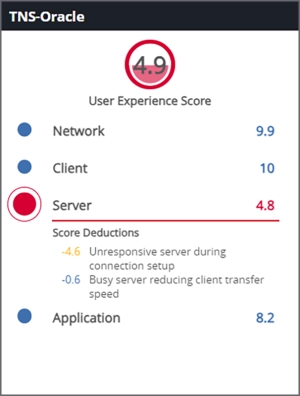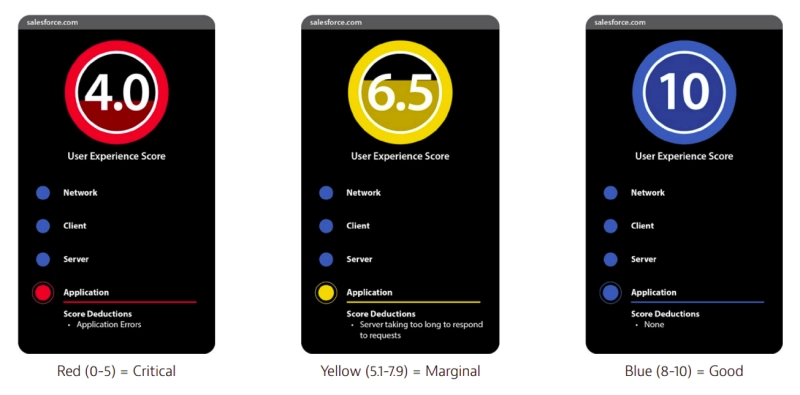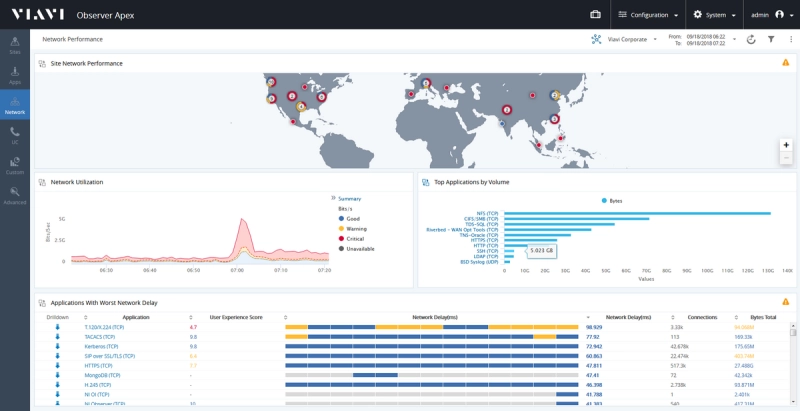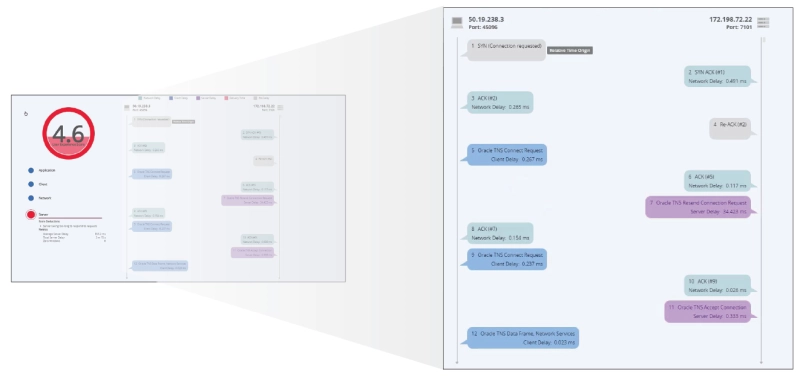End-User Experience Monitoring
The Observer platform provides insightful, intuitive scoring from the end user’s perspective.
End-User Experience Monitoring from VIAVI
Monitoring, troubleshooting, and complaint resolution activities stretch IT teams to their limits. Remote working and cloud migration only add to this burden. It is no longer feasible to assess network health by reviewing endless lists of KPIs with no clear focus or direction. A simple and effective method of End-User Experience monitoring to gauge the actual usability experience of our end-users is the priority. The End-User Experience Monitoring solution from VIAVI automatically interprets volumes of complex packet data and produces a simple actionable score via our patented algorithm. The results are provided via intuitive workflows, with out-of-the-box and customizable dashboards. Issues are quickly isolated to the network, application, server, or client domain including detailed score deductions that drive issue prioritization and efficient resolution.
Important End-User Experience Monitoring Metrics
The volume and diversity of data available to IT teams provides greater depth of analytics than was previously possible. Rather than simply collecting and presenting an overwhelming collection of results, automated scoring, prioritization, and domain isolation arms IT staff with the essential actionable information needed to improve or restore the end-users’ experience.

EUE domain isolation and detailed score deductions automate problem identification and prioritization
Overcoming Network Monitoring Challenges
Real-time network analysis is vital for addressing performance and security issues. As cloud adoption, IoT, and diverse monitoring tools expand data sources, focusing on the end-user experience (EUE) helps overcome these common challenges:
- KPI Overload: Too many metrics can cause confusion and delay resolution. EUE scoring simplifies data by distilling key insights into a single, user-focused value, improving prioritization and reducing mean time to identify (MTTI).
- Siloed Teams: Cloud infrastructure often limits visibility and complicates collaboration. EUE scoring bridges functional gaps, enabling NetOps, SecOps, and other teams to isolate issues and quickly assign the right response team.
- Resource Constraints: More data can overwhelm Tier 3 engineers, delaying critical projects. EUE monitoring empowers Tier 1 and 2 teams with intuitive tools to visualize problem domains, reducing troubleshooting time and freeing resources for innovation.
Application Performance from a User’s Perspective
End-User Experience monitoring tools from VIAVI make it easy to navigate from a high-level global summary dashboard to the root cause of issues to enhance end-user satisfaction in just a few steps:
- Review Scores: The dashboard visually displays which applications, tiers, and sites are performing poorly based on end-user monitoring. Color coding highlights any problem areas.
- Review Performance Details: Clicking on any End-User Experience Score brings up a scorecard with a breakdown of network, client, server, and application performance, with a precise breakdown of the individual score deductions.
- On-demand Application Dependency Maps: Once the nature of the problem is identified on the scorecard, auto-generated dependency maps illustrate the source of the issue in greater detail.
- Connection Dynamics: Individual network conversations can be visualized in a simple ladder diagram that includes requests, responses, and associated timings. When combined with EUE scoring and domain isolation, this powerful visualization drives root cause identification without having to look at individual packets.
Packet Capture: When packet data is desired for in-depth analysis, unabridged PCAP files can be accessed via a single click.

Connection Dynamics combined with EUE scoring automates conversation-level troubleshooting
End-User Experience Monitoring Approach from VIAVI
Attempting to analyze and correlate dozens of metrics manually has been a common approach for evaluating user experience. A better, more efficient, automated approach is needed.
- VIAVI Observer leverages machine learning as it runs dozens of KPI inputs through multiple algorithms, resulting in one intuitive and actionable score. This eliminates the noise and false positives that can lessen the value of traditional performance analysis methods.
- VIAVI Observer provides visibility in the cloud. Providing EUE scoring in AWS restores visibility that is often lost during cloud migrations and ensures clear issues ownership and accountability.
- New scoring innovations continue to evolve as analysis methods improve. VIAVI EUE scoring has evolved beyond basic domain isolation to provide a detailed breakdown of every individual score deduction, simplifying the process of understanding which issues are really the cause of performance degradation to be prioritized ahead of less-impactful problems.
Patented End-User Experience Scoring
The single numeric score generated by Observer Apex is calculated based on analyzing multiple network KPIs. This approach leads to actionable End-User Experience scoring results and the ability to quickly isolate the problem domain to Application, Server, Network, or Client.
- Scores ranging from 1-10 can reflect how an application or service is performing, a single user’s experience, or a group of users defined by site, geolocation, etc.
- 'Red scores' identify the most urgent issues, while yellow scores indicate a less serious (marginal) degradation.
- Scores are calculated in real-time and retained over extended periods to assure both short and long-term end-user high-fidelity satisfaction.

End-User Experience Monitoring Revolutionized
By focusing on end-user satisfaction and customer collaboration, VIAVI has defined the performance metrics that matter most. Industry-leading network performance monitoring solutions have converted this expertise and insight into unprecedented visibility and optimized service delivery.
- Observer Apex is the first network performance monitoring solution to generate an end-user experience score for every transaction. By integrating multiple data sources (such as packet and flow), Apex provides the industry’s most comprehensive end to end-user experience monitoring. Intuitive dashboards are easily customizable to address specific business and IT priorities. Observer network forensics support deep dive investigations with high fidelity data sources.

Literatur
Video
Wir helfen Ihnen gern
Wir sind dafür da, Ihnen zu helfen.



